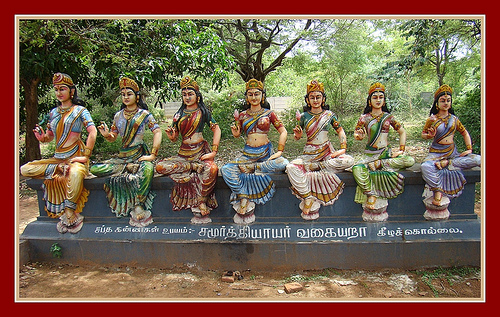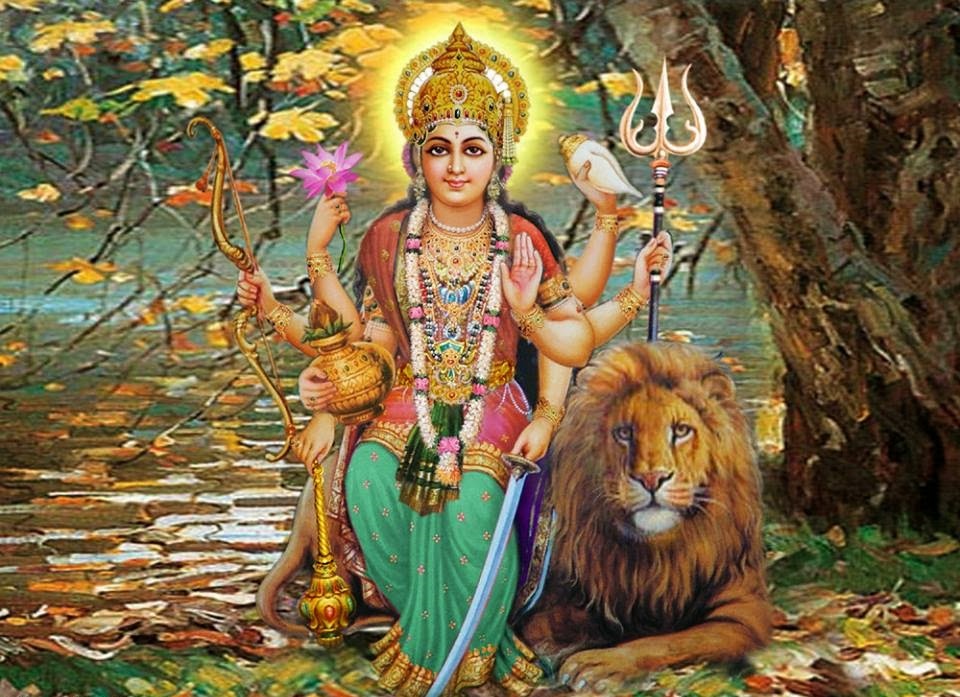No products in the cart.
The Sapta Matrika are affiliated to Mother Shakti and Skanda, the warrior god. ‘Matrikas’ means mother and ‘Matris’ indicate a group of mothers. Thus Sapta-Matrikas means Seven Mothers. They are part and parcel of Mother Worship. At times the Matrikas are worshiped as Ashtamatrika with one additional Goddess. They are all incarnations of Goddess Shakti and their character and depiction is regional rather than having a constant principle. They are generally described to have auspicious qualities. The general consensus is that the Sapta-Matrikas appeared to defeat the thousands of Andhaka’s that were born from the blood of the demon Andhaka.
Sapta Matrika Puja
The Devi Purana mentions the names of the flowers used for the worship of Matrikas. The Sapta Matrikas images are worshipped by women on Pithori – new moon day, with the 64 yoginis represented by rice flour images or supari nuts. The goddesses are worshipped by ceremonial offerings of fruit and flower and mantras. It is believed that when the Matrikas are angry, they make women barren or strike newborns with fatal fevers. Thus mothers quick with child or prospective mothers pray to the Matrikas for health and happiness. The Sapta Matrikas are also prayed to get rid of the evil effects of witchcraft.
The Sapta-Matrikas portray beautiful allegory. Siva is the spirit of Vidya, knowledge. Andhaka represents, ignorance or the darkness of Avidya. The more Vidya attacks Avidya the more it tends to arise and increase. This is represented by the multiplication of Andhaka and secondary asuras. Unless the eight evil qualities, Kama, krodh, lobha, mada, moha, matsarya, paisunya and asuya are completely brought under the control of Vidya and kept under restraint, it can never succeed in putting down Andhakara. The Varaha Purana state that the Matrikas are Atma-Vidya warring against Andhakara. The darkness of ignorance: “Etate-te Sarvam-akyatamatma-vidyamritam”
Usually in Sapta Matrikas worship, Chamunda replaces Narasimhi as the last Mother. The Dhatus or body substances ruled by the Matrikas are Brahmani: skin, Maheshvari: blood, Kaumari: muscle, Vaishnavi: fat, Varahi: bone, Aindri: marrow and Chamunda: semen. In Nepal, the Matrikas are placed according to the eight compass directions. North-west, is assigned to Durga Mahalakshmi, from whom the Matrikas emerged.
Sapta Matrika Names and Mantra
![]()

Sapta Matrika – Brahmani
This goddess has four faces and a body bright as gold. In the back right hand, she carries the Sula and in the back left hand as Aksha-maalaa; the front right hand is in the Abhaya pose and the front left hand in the Varada pose. She is seated upon a red Lotus and has the Hamsa as her Vahana as also the emblem of her banner. She wears a Pitambara or yellow garment. Her head is adorned with a Karandmakuta. Her situation is under a palasa tree. Such is the description of her in the Amsumadbhedagama.
Sapta Matrika Mantra – Brahmani
Aum Dhevee Brahmani Vidmahe
Maha-shakthiyai Cha Dhimahee
Thanno Dhevee Prachodayath
Sapta Matrika – Vaishnavi
Vaishnavi holds the Chakra and Sankha in her right and left hands. The other hands are held in the Abhaya and the Varada poses. She has a lovely face and beautiful breasts and is of dark complexion. Her eyes are pretty, and she wears a yellow garment. On her head is a Kirita-makuta. She is adorned with all the ornaments generally worn by Vishnu, and the emblem of her banner. Her vahana is the Garuda. Her place is under a Rajavriksha. In Devi Purana, she is represented as possessing four hands in which she carries the Sankha, Chakra, Gada and Padma. She wears Vishnu’s garland, the Vanamaalee.
Sapta Matrika Mantra – Vaishnavi
Aum Thaarksh Yathwajaaya Vidmahe
Chakra Hasthaya Dhimahee
Thanno Vaishnavi Prachodayath
Sapta Matrika – Indrani
The figure of Indrani has three eyes and four arms; in two of her hands she carries the Vajra and Sakthi, the two other hands being respectively held in the Varada and Abhaya poses. The colour of goddess is red, and she has on her head a Kirita Makuta. The color of her body is red. She is heavily ornamented. Her vahana as well as the emblem of her banner is the elephant. Her abode is under the Kalpaka tree. The Devi-purana states that she carries the Ankusa and the Vajra only, the Purvakaranagama mentions that she has only two eyes which is slightly different from Vishnudharmottara which states that she has a thousand eyes. According to the last authority, the Goddess Indrani holds a lotus in one of her hands.
Sapta Matrika Mantra – Indrani
Aum Gajath-vajaayai Vidmahe
Vajra Hasthaya Dhimahee
Thanno Indrani Prachodayath
Sapta Matrika – Chamunda
The Goddess Chamunda has four arms and three eyes and is red in colour. Her hair is abundant and thick and bristles upwards. She has Kapala, Skull in one hand and Sula in another while the other two hands are respectively in the Abhaya and Varada poses. She wears a garland of sculls in the manner of the Yajnopavita and is seated upon Padmasana. Her garment is the tiger skin, and her bode is under a fig tree. Her seat, it is said in the Vishnudharmottara, is the dead body of a human being, and she has a terrific face with powerful tusks. She has a very emaciated body and sunken eyes and ten hands. The belly of this goddess is thin and apparently empty. She carries in her hand the following things: Musala, Kavacha, Bana, Ankusa, Khadga, Khetaka, Dhanush, Danda and Parasu.
Sapta Matrika Mantra – Chamunda
Aum Pisaasath-vajaaya Vidmahe
Soola Hasthaya Dhimahee
Thanno Kali Prachodayath
Sapta Matrika – Maheshvari
She is of white complexion. Maheshvari has four arms; two of which are in the Abhaya and Varada Poses while the remaining two hands carry the Sula and Aksha-maalaa. Her Vahana is the Bull. This Goddess is said in the Vishnudharmottara to have five faces, each possessing three eyes and she wears on her crown the crescent moon. She has six arms; in four of the hands she carries the Sutra, Damaru, Sula and Ghanta, the two remaining hands being respectively in the Abhaya and Varada poses, her head is adorned with the jata-mukuta. Her banner also has the Bull for its emblem.
Sapta Matrika Mantra – Maheshvari
Aum Vrushath-vajaaya Vidmahe
Miruga Hasthaya Dhimahee
Thanno Rowthree Prachodayath
Sapta Matrika – Kumari
She is of yellow complexion. She is the female manifestation of Lord Subrahmanya who is known as Kumara. Kumari has four hands, in two of which she carries the Sakti and the Kukkuta, the remaining two hands being respectively in the Abhaya and Varada poses. Her Vahana, like that of Kumara, is the Peacock, which is also the emblem on her banner. She has a Jata Makuta said to be bound with Vasika or Vachika. Her abode is under an Udumbarah or Fig tree. She has, according to the Vishnudharmottara, six faces and twelve arms, two of her hands being respectively held in the Abhaya and Varada poses, and she carries the Sakti, Dhvaja, Danda, Dhanush, Bana, Ghanta, Padma, Patra and Parasu in her other hands. The Devi Purana adds that her garland is made of red flowers. She is sculptured to suggest the ideas of Valour and Courage.
Sapta Matrika Mantra – Kumari
Aum Sikid-vajaaya Vidmahe
Vajra Hasthaya Dhimahee
Thanno Kumari Prachodayath
Sapta Matrika – Varahi
Varahi has the face of a boar and the colour of the storm-cloud. As such, she is dark complexioned. She wears on her head a Karanda-Makuta and is adorned with ornaments made of corals. She wields the Hala and Sakti and is seated under a Kalpaka tree. Her Vahana as well as the emblem on her banner is the elephant. To this description the Vishnudharmottara adds that she has a big belly. According to this authority, she has six hands in four of which she carries the Danda, Khadga, Khetaka and Pasa, the two remaining hands being respectively held in the Abhaya and Varada poses. The Purvakaranagama says that she carries the Saringapdhanus, the Hala and Musala as her weapons. She wears on her legs Nupura-anklets.
Sapta Matrika Mantra – Varahi
Aum Varaaha-muhi Vidmahe
Aanthra-shani Dhimahee
Thanno Yamuna Prachodayath
Sculptures of Saptamatrika
This is prescribed in Suprabhedagama Agama. The sculptures are referred to as ‘Krityaratnakara’. The sculpturing of the Sapta Matrikas group of Gods and Goddesses are described in the Suprabhedagama. Their sculptures in the cave temples of Ellora conform largely to the descriptions in this text. The Sapta Matrikas are to take the forms of their consorts. Thus Brahmani should be sculptured like Brahma; Maheswari like Maheswarah, Vaishnavi like Vishnu, Varahi as a short woman with an angry face and bearing a plough as her weapon; Indrani like Indra. Chamundi, the lst description is to be depicted as a terrific goddess in disheveled condition and wield Trisula in one of her hands and carry a Kapala in another. They are shown seated upon Padmasana in the sculptures and hands held in the Varada and Abhaya poses or carry appropriate weapons.







Namaste. Why on the Varaji gayatri mantra the Yamuna is mentioned in the last line of sloka?